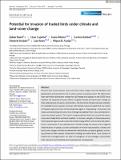Por favor, use este identificador para citar o enlazar a este item:
http://hdl.handle.net/10261/279050COMPARTIR / EXPORTAR:
 SHARE SHARE
 CORE
BASE CORE
BASE
|
|
| Visualizar otros formatos: MARC | Dublin Core | RDF | ORE | MODS | METS | DIDL | DATACITE | |

| Título: | Potential for invasion of traded birds under climate and land-cover change |
Autor: | Naimi, Babak; Capinha, César; Ribeiro, Joana; Strubbe, Diederik; Reino, Luís; Araújo, Miguel B. CSIC ORCID | Palabras clave: | Biological invasions CITES Climate change Land use change traded birds Risk analysis |
Fecha de publicación: | 18-jul-2022 | Editor: | John Wiley & Sons | Citación: | Global Change Biology 28(19): 5654-5666 (2022) | Resumen: | Humans have moved species away from their native ranges since the Neolithic, but globalization accelerated the rate at which species are being moved. We fitted more than half million distribution models for 610 traded bird species on the CITES list to examine the separate and joint effects of global climate and land-cover change on their potential end-of-century distributions. We found that climate-induced suitability for modelled invasive species increases with latitude, because traded birds are mainly of tropical origin and much of the temperate region is ‘tropicalizing.’ Conversely, the tropics are becoming more arid, thus limiting the potential from cross-continental in vasion by tropical species. This trend is compounded by forest loss around the tropics since most traded birds are forest dwellers. In contrast, net gains in forest area across the temperate region could compound climate change effects and increase the potential for colonization of low-latitude birds. Climate change has always led to regional redistributions of species, but the combination of human transportation, climate, and land-cover changes will likely accelerate the redistribution of species globally, increas ing chances of alien species successfully invading non-native lands. Such process of biodiversity homogenization can lead to emergence of non-analogue communities with unknown environmental and socioeconomic consequences. | Versión del editor: | https://doi.org/10.1111/gcb.16310 | URI: | http://hdl.handle.net/10261/279050 | DOI: | 10.1111/gcb.16310 | ISSN: | 1354-1013 | E-ISSN: | 1365-2486 |
| Aparece en las colecciones: | (MNCN) Artículos |
Ficheros en este ítem:
| Fichero | Descripción | Tamaño | Formato | |
|---|---|---|---|---|
| Bastos_MB_Potential.pdf | Artículo principal | 11,9 MB | Adobe PDF |  Visualizar/Abrir |
CORE Recommender
SCOPUSTM
Citations
12
checked on 24-abr-2024
WEB OF SCIENCETM
Citations
8
checked on 20-feb-2024
Page view(s)
34
checked on 23-abr-2024
Download(s)
40
checked on 23-abr-2024
Google ScholarTM
Check
Altmetric
Altmetric
Este item está licenciado bajo una Licencia Creative Commons



